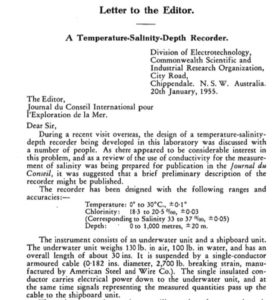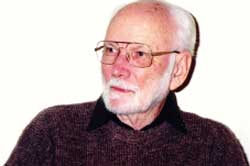The Aussies’ crucial contribution


In 1958, in Australia, at CSIRO Division of Fisheries and Oceanography Bruce Hamon (1917-2014) and Neil Brown (1927-2005), the ”fathers” of the modern CTD-systems, described a “Temperature-Chlorinity-Depth” recorder, designed for use at depth to 1000 meters.
The accuracy for temperature was within ± 0.15°C, for chlorinity ± 0.03ppt and depth ± 20m. Chlorinity was measured using a conductivity cell with two electrodes and a circuit including thermistors and resistors to compensate for the effect of temperature on conductivity. A simple phase shift oscillator converts the information coming from each sensor into a frequency-modulated audio signal. This signal was transmitted to a ship, where it was converted to direct DC voltage and recorded on a strip-chart recorder.

In 1959, Neil Brown left Australia to settle in Woods Hole (MA, USA) with Woods Hole Oceanographic Institute and work with A.Bradshaw and K.Schleicher to understand what could be done with a more accurate in situ measuring instrument. It used an inductive conductivity sensor and a sealed compensation cell filled with standard seawater. This cell was intended to accurately compensate for the simultaneous effects of temperature and pressure.
It was a brilliant solution in the absence of relations between conductivity, temperature, and pressure of seawater, implemented in the form of measurements of relative conductivity (Rt). Such a measuring system has a significant time constant due to slow temperature stabilization in the sealed reference cell, and its application requires special methodological solutions when conducting measurements in profiling mode. I know it from my own experience of developing a Microsalinometer MS-310 with a similar ratiometric principle of measurement. In fact, it was a submersible “salinity bridge”, or a submersible salinometer, as often named then. All team was familiar with the development of laboratory salinometers (see Development of Salinometers) and using so complicated compensation schematic was a reflection of a lack of knowledge on conductivity-temperature-pressure relations for seawater at the end of 1950th. Salinity determination in Oceanography was performed then mostly by Chlorinity titration and even ship’s laboratory “salinity bridges” were set to specific deep-ocean temperatures to minimize the effect of temperature on conductivity ratio. It will take another 20 years to develop the Practical Salinity Scale – 1978 to resolve this problem. Unfortunately, WHOI did not recognize the uniqueness of this measurement system and future work to improve it design was terminated. N.Brown returned to Australia in 1961…






 Visit Today : 30
Visit Today : 30 Visit Yesterday : 171
Visit Yesterday : 171 This Month : 3831
This Month : 3831 Total Visit : 211309
Total Visit : 211309 Hits Today : 43
Hits Today : 43 Total Hits : 567787
Total Hits : 567787 Who's Online : 2
Who's Online : 2